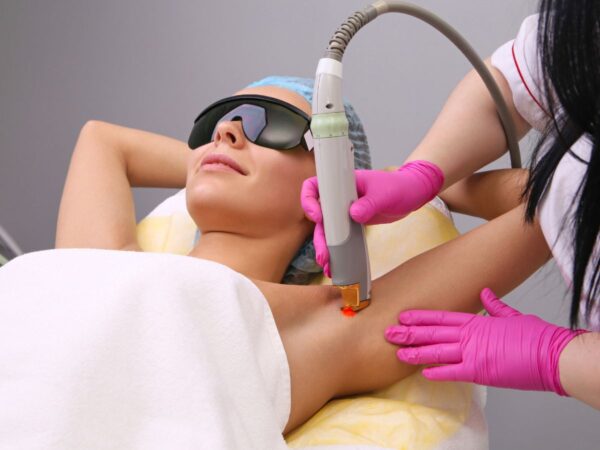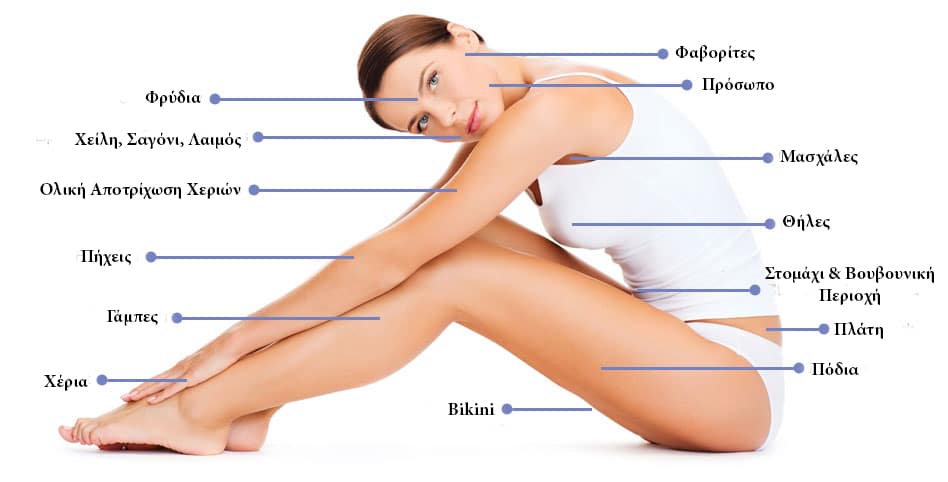Laser Hair Removal - How it works
The lasers used for hair removal emit a monochromatic light with a specific wavelength (the Alexandrite we use works at 755nm) which is selectively absorbed by the melanocytes found in the hair. It causes in this way selective destruction of the hair follicle (hair root) located inside the skin. The hair shaft (the part of the hair that projects outside the skin) does not interest us at all in this application, that is why in the instructions we give we suggest that they come with the area recently shaved or with the hair shaft cut with scissors.
Types of laser hair removal
Three different technologies are used for medical laser hair removal. The Alexandrite laser that emits at 755nm (this type of laser we use in our clinic because we believe it has the best result while also offering the most painless application), the diode (Diode) laser that emits at 805nm and the long pulse Nd -Yag Laser at 1064nm (which is essentially only aimed at very dark and black skins and is the most painful laser in its application)
But we should know that not all Laser Alexandrite hair removal machines are the same! The differences concern the effectiveness of the application (it depends on how well it can be customized based on the parameters of each case), how painless the application will be (this depends on how good the cooling system that comes with the machine), the time in which the application is completed (this has to do with the speed of the machine but also the size of the head-spot size it can support)
In our clinic we use the top Lutronic Clarity 2 Alexandrite laser which excels in all the above areas and is also so effective that no repeat session was needed. It has all FDA, CE certifications
We would recommend that before you trust somewhere to apply your laser hair removal, you should also be interested in the quality of the machine that will be used.
When should laser hair removal be done for medical reasons?
In some patients who have very thick or even hard hair after depilation with the classic methods (shaving, waxing, depilatory creams, depilatory machines), intense folliculitis (red inflamed pimples with pus) is created in the area. This folliculitis can be due to a staphylococcus that enters the follicle (root) of the hair due to the microtrauma caused by the classic hair removal methods or to a hair that "turned" inside the skin
This folliculitis especially in people with a dark skin type can leave permanent spots on the skin (post-inflammatory hyperpillosis). In these cases, we recommend laser hair removal to have a definitive solution to the issue of unwanted hair growth.
Also some patients have sensitive skin that shows severe irritations and allergic reactions (eg contact dermatitis) from depilatory creams and these patients benefit greatly from laser hair removal
In addition, patients with a history of papillomas or warts (infection of the skin by a virus of the HPV family) have a significant benefit from laser hair removal because it helps a lot in preventing the lesions from spreading due to injury.
Finally, patients who suffer from or have already been operated on for "coccygeal cyst" benefit greatly from the permanent hair removal of the area which helps to prevent the disease from recurring
Before & After Treatment
You can see the course of each treatment in the slider below. By pressing the arrows at the bottom you can see the result per session
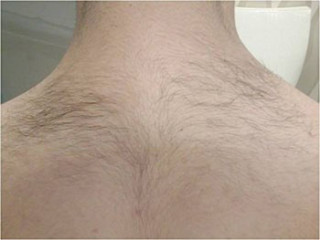
Before the first session
On a man's back
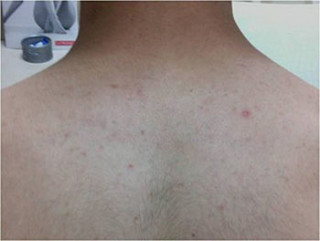
After the first session
On a man's back
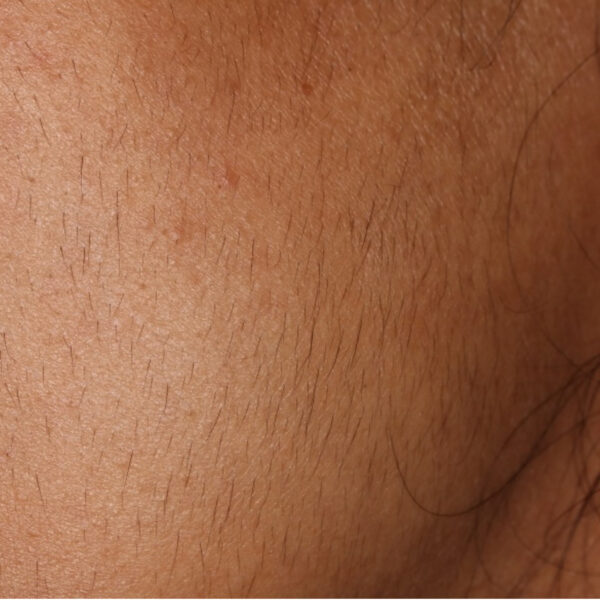
Before the first session
In a teenage girl's face
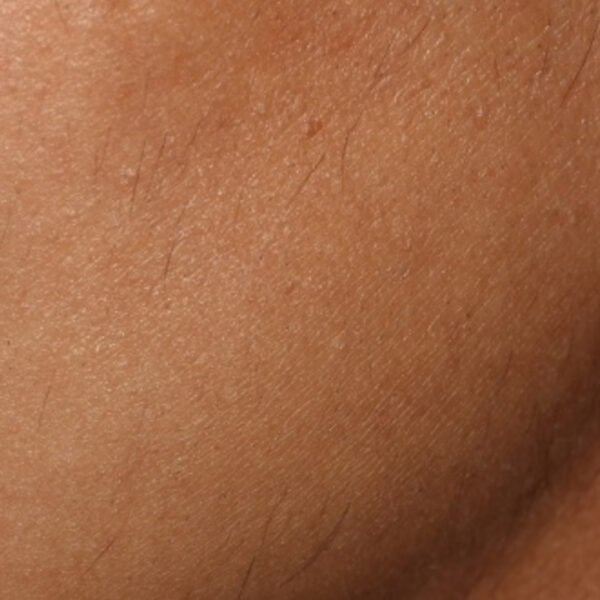
After the first session
In a teenage girl's face
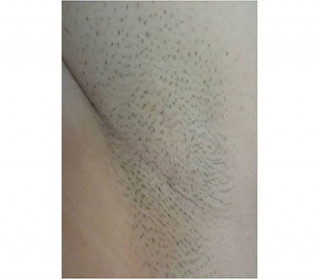
Before the first session
In the armpit of an adult
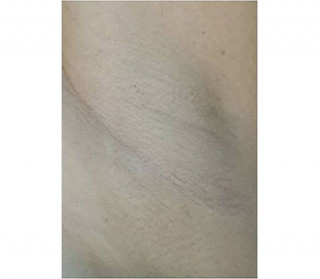
After the first session
In the armpit of an adult
Instructions (preparation) before applying laser hair removal
It must not be preceded by any depilatory method that removes the hair for a period of one month before the application of the laser. This is because if a wax or silkepil is used before the application of the laser, they uproot the hair along with its root, so the laser will not be able to target the root of the hair and achieve its effective destruction. For the same reason, it is not allowed to use wax during the entire time we are doing laser hair removal (in between applications we can use a razor if this is necessary).
Also, the area to be depilated must be shaved (or the facial hair cut with scissors) 2-3 days before the application of the laser. This ensures that the energy of the laser will be utilized exactly where it should be (ie at the root of the hair) and not at the hair shaft (the part of the hair that protrudes above the skin). Also, if the laser "hits" the hair shaft, it will melt and create a burn mark on the surface of the skin, which is also undesirable.
As a conclusion, we must shave the area 2-3 days before each application, and avoid for the entire duration of the laser treatment hair removal methods that remove the hair.
Immediately after the application of laser hair removal, we apply a moisturizing soothing cream which relieves the mild irritation caused by the application (from the "bursting" of the hair root inside the skin). At home, the use of a simple moisturizer can be continued for 2-3 days. No additional care is required
First of all, we should clarify that IPL or pulsed light or photolysis is misleadingly referred to by various institutes as "laser hair removal". Photolysis is a completely different technology. It produces a wide range of radiation from 500-1200nm (it is not monochromatic radiation with one wavelength like the laser) so that it cannot be adjusted and accurately predicted the depth of the skin where the hair removal is applied. The energy produced by IPL is smaller and more diffused. Also, the way the laser is set up to make the application can be precise and personalized to be ideal for each case (depending on the combination of skin color and hair color), while IPL works better on specific (open) types skin. For this reason, the laser is safe to use on all skin types (if the operator has the required experience). The laser requires much fewer sessions to achieve the final result because it is a more powerful medical machine and can transfer more energy to the target location (hair root). Also, due to better penetration of the laser (compared to IPL), it can also be effective on larger diameter (thick) hairs that are deeper in the skin (e.g. on the back). Finally, the laser excels because it has a much better cooling system which makes the application painless
Excessive hair growth can be due to heredity, endocrinological (hormonal) disorders such as polycystic ovary syndrome and insulin resistance, thyroid problems. But it can also be due to specific medication treatments that we have started, to the normal aging process as well as excessive use of depilatory methods which affect the root of the hair.
Usually before we start the laser treatment we do an investigation (laboratory check with blood tests, gynecological ultrasound) for the pathological causes of hirsutism especially when there is excessive hair growth or when there is hair growth in areas that should not be there (in the jaw-chin area in women or below the navel in women etc.)
There are no significant absolute contraindications. Relative contraindications for laser hair removal are a history of photodermatitis and taking photosensitizing drugs, although we have successfully performed sessions in such more difficult cases. Related contraindications are pregnancy and lactation, and we ask for the consent of a gynecologist, although the laser does not pose any risks to the fetus and newborn.
For people who have permanent tattoos, we avoid doing treatment on the tattoo in order not to alter the color
Also, in people who have many pigmented moles (olives) on the skin, we avoid treating the olives that have melanin in order not to injure them
A relative contraindication is a history of epileptic seizures, as the flashes caused by the laser can trigger an episode. Of course, in patients who are under treatment and we completely protect them from seeing these flashes, we do not face any problem.
Another contraindication is tanned skin from exposure to the sun or artificial light sources (solarium). This skin has more melanin and is more at risk of burning. It is good to avoid hair removal or, in case of a small color change, to do the session more conservatively (lower energies) and with a special setting of the laser so that it is safe.
The only side effect seen is a little redness and the formation of small bumps (bumps of skin right where the hair follicle openings are on the skin) which can be mildly itchy. These are fully reversible and only last for a few hours after treatment. Essentially, this is not an unwanted effect but the result of the "explosion" of the hair bulb (root), with the effect of the laser, inside the skin (it means that we have achieved effective hair removal!). They are easily treated by applying a moisturizing anti-inflammatory cream to the skin after application.
The fears many have that underlying non-melanin structures and organs such as lymph nodes and mass gland (breast) may be affected are completely unfounded.
Practically hair removal is done in every area where there is unwanted hair growth. On the face (upper lip, cheeks, chin, sideburns, eyebrows) but also on the body such as on the hands (arms and forearms) on the armpits, bikini, on the legs (thighs, shins) but also on the back and chest, nipples and belly.
There is no contraindication regarding the age at which we can start the application. The reason we usually start after puberty is so that the sex hormones have stabilized and we get a better result. In any case, the laser cannot cause any harm, it does not affect internally at all, neither the development of the child, nor the development of hormones. It is only at young ages that a greater number of sessions may be needed. In any case, we also calculate the burden on the child's psychology from unwanted hair growth.
The energy of the hair removal laser is absorbed by the melanin. So the application works best on brown and dark hair. In blonde hair, we will get a result with special parameterization of the application, but more sessions will be needed. Finally, the application cannot work on completely discolored (white) hair.
Of course it can be done. One of the innovations of the Alexandrite Clarity 2 laser is that the application can be done even on tanned skin throughout the year.
Most patients need at least 5-6 sessions spaced approximately 4 weeks apart. Also, in patients with polycystic ovary syndrome, very good regulation of the disease is needed and the restoration of hormone values to normal levels so that we can expect effective hair removal.
The areas with the best laser hair removal results are the bikini area, armpits and legs, while the face can persist longer. The result of permanent hair removal comes later in men who have a greater amount of circulating androgens in the blood.
In any case, the continuous use of sunscreen with a protection index of 50 on the face and body is mandatory when exposed to the sun after the sessions.
The older generation lasers needed every 15-20 days a repeat session, after the regular session. In addition, it was also a Marketing trick to sell more packages to the beauty salons. In our clinic no repeat session is required, the Alexandrite laser we use is of the latest generation and hair loss is immediate as are its results
No. The application is made with simultaneous very strong cooling of the area with cold air. This cooling guarantees safety for the treatment and painless treatment. Only a small percentage of patients resort to the use of anesthetic cream (EMLA) only for the bikini area, which is considered the most sensitive to pain.
It can be done┬Ālaser hair removal during pregnancy?
Related contraindications are pregnancy and lactation, and we ask for the consent of a gynecologist, although the laser does not pose any risks to the fetus and newborn. Of course, the hormonal changes that occur during pregnancy often make laser hair removal ineffective. And for this reason we prefer to start or continue (in case there was a pause) hair removal sessions after pregnancy
Ask us for a free consultation appointment. We will explain to you what you need to do before starting laser hair removal, we will inform you according to your skin type and hair color and density of the number of sessions you will need and the cost.
It can be done┬Ālaser hair removal during pregnancy?
Related contraindications are pregnancy and lactation, and we ask for the consent of a gynecologist, although the laser does not pose any risks to the fetus and newborn. Of course, the hormonal changes that occur during pregnancy often make laser hair removal ineffective. And for this reason we prefer to start or continue (in case there was a pause) hair removal sessions after pregnancy
More clearly hair removal packages are more economical than waxing individual areas. Ask us for a quote online through our website or better yet stop by the practice for a free consultation visit.
Because in our clinic we use the leading Alexandrite laser from the American company LightAge, the Epicare LPX, which excels in all areas of safety, efficiency and speed. It has all FDA, CE certifications.
In addition, the partners who make the application are trained and very experienced.

